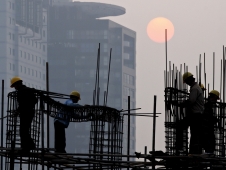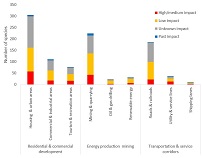
Ongoing infrastructure development—encompassing residential and commercial growth, energy production, mining, transport and dams—poses a serious threat to the world’s birds. Residential and commercial development is having the greatest impact, affecting nearly 28% of all threatened species, with a high proportion in Asian-Pacific countries.

It is predicted that by 2032 over 70% of the Earth’s land surface will have been impacted by infrastructure development (UNEP 2002). Unless this expansion is better controlled and planned than at present, it will cause a substantial increase in environmental problems relating to habitats, biodiversity, food production, freshwater resources and health. Latin America and the Caribbean are forecast to be the hardest hit, with more than 80% of the land significantly affected, but the rapidly developing Asia–Pacific region follows close behind, with more than 75% of land area predicted to be affected in this way (UNEP 2002).
The most significant threat to birds comes from urbanization, which is affecting 305 species (21% of threatened birds), but mining/quarrying and roads/railroads are also threatening developments, impacting 225 (15%) and 186 (13%) threatened species respectively (BirdLife International 2016). Urban development is occurring most rapidly in Asia (ESCAP 2007) and as a consequence this region holds a very high number of species threatened by residential and commercial development (32% of all species so affected).
Related Case Studies in other sections
References
Compiled: 2004 Last updated: 2017
Recommended Citation:
BirdLife International (2017)
Threatened birds indicate the consequences of unchecked infrastructure development.
Downloaded from https://datazone.birdlife.org/sowb/casestudy/threatened-birds-indicate-the-consequences-of-unchecked-infrastructure-development on 22/12/2024